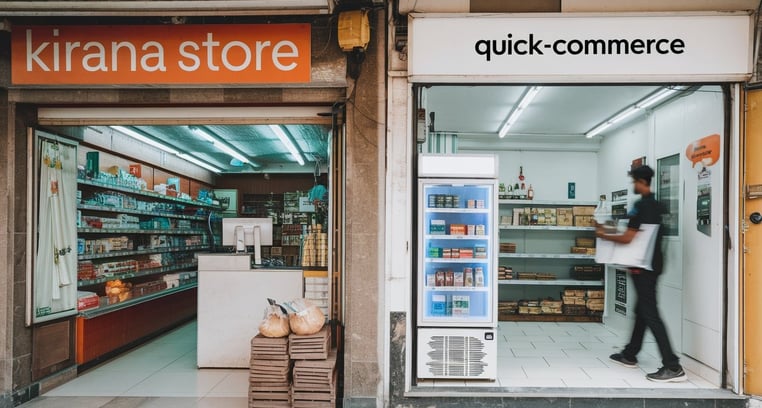Kirana Stores vs. Quick Commerce: A Shift in India’s Retail Landscape
This blog post explores the evolving retail landscape in India, focusing on the competition between traditional kirana stores and quick-commerce platforms like Blinkit, Zepto, and Swiggy Instamart. Discover how quick commerce is reshaping convenience for urban consumers, especially younger shoppers, while examining the strengths of kirana stores. We highlight the challenges both models face and how kiranas are adapting through digital solutions. Join us to understand the potential for a hybrid retail environment that combines the personal touch of kirana stores with the efficiency of quick commerce.
Astitva Dubey
10/30/20242 min read


The Rise of Quick Commerce
In recent years, India’s retail sector has experienced a significant transformation as quick-commerce platforms like Blinkit, Zepto, and Swiggy Instamart challenge the traditional kirana store model. With promises of instant delivery in mere minutes, these platforms are redefining convenience for urban consumers, especially the younger, tech-savvy demographic that values speed and digital accessibility. This surge in popularity has raised important questions about the impact of quick commerce on the longstanding kirana model and what the future of retail in India might hold.
Traditional Kirana Stores: Backbone of Local Commerce
Kirana stores have been integral to Indian communities for decades, nurturing loyal customer bases through personalized service and familiarity. These small retail outlets are known for their flexibility, offering credit lines, customized product suggestions, and a trust-based shopping experience. Kirana stores thrive on strong relationships with their customers, adapting to local needs and preferences—something that quick-commerce giants still struggle to fully achieve. Despite their lack of sophisticated inventory systems, many kiranas ensure fast service and remain highly responsive to local demands.
Quick Commerce: A New Era of Convenience
Quick commerce has ushered in a new era of convenience, allowing consumers to access a vast range of products with just a few taps on their smartphones. The appeal of 10- or 15-minute delivery for groceries, personal care items, and snacks caters directly to urban lifestyles. Quick-commerce platforms leverage technology to track inventory, plan delivery routes, and ensure efficient service. Additionally, frequent discounts and promotions help attract price-sensitive customers, further enhancing their competitive edge in the market.
Challenges for Kirana Stores
While kirana stores play a crucial role in local commerce, they face several challenges in this rapidly changing landscape:
Limited Reach: Unlike quick-commerce platforms, kiranas usually serve specific local areas, which limits their market reach.
Less Tech-Driven: Most kiranas operate without tech-driven inventory systems, making it difficult to compete with the dynamic, data-backed approach of quick commerce.
Pricing Pressure: With quick-commerce platforms frequently offering discounts, kiranas often struggle to maintain customer loyalty, particularly among the youth who prioritize cost-saving options.
The Adaptation: Kirana Stores Going Digital
To remain relevant, many kirana stores are adopting digital solutions. They are partnering with e-commerce platforms like Amazon and JioMart, listing their products online, and offering doorstep delivery. These partnerships help bridge the gap between traditional and modern retail, enabling kiranas to retain their loyal customers while reaching new audiences. Moreover, some kiranas are implementing basic tech upgrades, such as digital payment options and simple point-of-sale (POS) systems, which streamline the shopping experience and align with customers' evolving expectations.
Blending the Old with the New
The competition between kirana stores and quick commerce illustrates the evolving landscape of India’s retail sector, where tradition meets technology. Both kiranas and quick commerce may continue to coexist, each adapting to meet specific consumer needs. While kirana stores provide a unique personal touch, quick commerce caters to the growing demand for speed and convenience. Together, these two models could create a hybrid retail environment, enriching the Indian consumer experience by combining local trust with modern technology.
